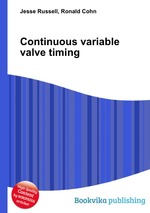Continuous variable valve timing
Jesse Russell Ronald Cohn
бумажная книга
High Quality Content by WIKIPEDIA articles! Continuous variable valve timing offers a unique ability to have independent control of the intake and exhaust valves in an internal combustion engine. For any engine load criteria, the timing of intake and exhaust can be independently programmed. The main variations of valve timing are: Late intake valve closing, Early Intake valve closing, Early Intake valve opening and early exhaust valve closing. These variations exist on a spectrum, which means engine performance could be optimized under all conditions. Variable Valve Timing has existed since Alfa Romeo implemented it in 1980. The technology took a big step forward with Honda’s VTEC system in 1987, which consists of two unique cam profiles for each intake/exhaust valve. The engine can then “decide” based on driving conditions which one to use to maximize performance. This certainly allows a greater degree of control over the engine with obvious performance benefits. However, if valve timing could be controlled independent of crankshaft rotation, then a near infinite number of valve timing scenarios could be accommodated which would dramatically improve fuel economy and emission levels of an automobile.


